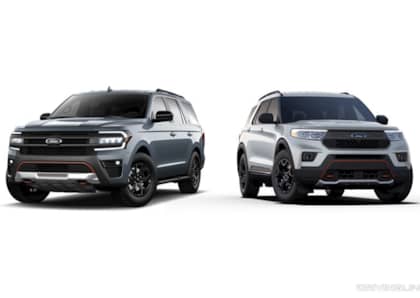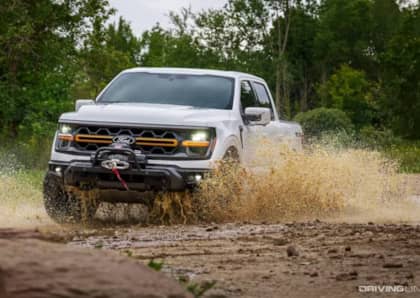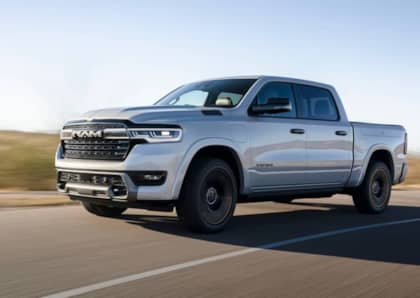5 Forgotten Ford Truck Concepts That Were Never Built (And What We Got Instead)
Not every concept truck built by Ford made it from the show circuit to the street. Although the Blue Oval has produced a long list of vehicles intended to showcase its future pickups and SUVs, most of them ended up locked away in a warehouse after the market shifted, consumer interests changed, or technical issues proved too challenging (or expensive) to deal with.
Why didn't these trucks make it, and what did we get instead of what we were promised? Here's a detailed look at five almost completely forgotten Ford concept trucks that were never built.
2004 Ford Bronco Concept
What Was It?
Nearly a decade after the Bronco had left showrooms Ford made waves with the Tonka-like two-door Bronco Concept at the Detroit Auto Show. All hard angles and chunky tires, the military proportions (and Land Rover Defender styling) of the new SUV were softened somewhat by a grille treatment that called to mind the original 1960s model.

Surprisingly, the Bronco Concept made use of a small-displacement turbodiesel engine, which was found only in European Ford vehicles at the time. It also came with a full glass roof and, potentially in a bid to appeal to the Fast and Furious crowd, a nitrous oxide system.
Why Was It Never Built?
2004 was a strange time for automotive styling, particularly at Ford. The automaker had just launched the retro-look Thunderbird, which failed to find an audience, and was about to unveil the 60s-influenced next-generation Mustang, which became a massive success.

With the Ford Explorer and Escape already covering the SUV mainstream, the uncertain appeal of old school shapes made Ford execs nervous about the Bronco's potential for success. The decision to back off proved prescient: surging fuel prices would kill off other body-on-frame off-roaders like the Hummer over the next few years, and the market for two-door 4x4s—even those like the old school look Toyota FJ Cruiser—was soft everywhere except for Jeep showrooms.
What Did We Get Instead?
It's tempting to say 'nothing.' Ford abandoned the off-road segment almost entirely in the 2000s, and by the time it came back to it was in the form of the F-150 Raptor pickup, not an SUV, for the 2010 model year.

On the sport-utility side it's possible to see hints of the Bronco Concept in the second generation Ford Escape as well as a twinkle in the eye of the fourth-generation Ford Explorer.
1999 Ford Himalaya Expedition
What Was It?
Ford's 1999 SEMA entry was a concept version of the Expedition full-size SUV that chopped off the rear bench and added an open pickup bed. Sound familiar? It's almost exactly the same formula used by Chevrolet with the Avalanche, minus the utility of the midgate that allowed for the extension of the cargo area into the passenger compartment.

The Himalaya also offered an open roof, a set of hardcore adjustable shock absorbers, a lift kit, and much better off-road capability than the standard Expedition. A net was draped over the box, which also featured an integrated roll bar, and a spare tire and a jerry can were affixed to the tailgate.
Why Was It Never Built?
If you're familiar with the genesis of the Expedition, then you know that it was built on the same chassis as the Ford F-150—which already offered four-door, crew cab pickup option in 1999.

In fact, without the midgate-like feature to sell potential buyers on the move from pickup to, well, slightly different pickup, it's hard to understand how the Himalaya Expedition would have found a spot in the Ford line-up.
What Did We Get Instead?
As with the corporate disinterest in the Bronco that came after it, Ford wasn't all that keen on a dedicated off-road model at the beginning of the 2000s.

That being said, the 2002 F-150 would benefit from the new FX4 trim level, which introduced Rancho shocks, a reinforced frame, and skid plates, all of which made the pickup that much more capable on the trail.
2003 Ford SVT Lightning Concept
What Was It?
A direct follow-up to the second-generation of Ford's fantastic performance truck, the Ford SVT Lightning Concept wowed the show circuit in 2003 with its 500hp supercharged 5.4-liter V8. Also capable of generating 500 lb-ft of torque, the pickup came with a six-speed manual gearbox and featured something called the Super Cooler, which chilled the air charge heading into the blower by way of the vehicle's air conditioning system.

(Sound familiar? That same tech was used in the Dodge Challenger SRT Demon over 15 years later, after Ford's patent had expired.)
Why Was It Never Built?
The first supercharged SVT Lightning had set the bar very high with its 380hp drivetrain. When the redesigned F-150 was on the drawing board, Ford planners realized very quickly that in order to overcome the extra weight of the new platform and stay just as frisky as its predecessor, any future Lightning would have to offer in the neighborhood of 500 ponies.

This was a problem, because Ford didn't have an automatic transmission that could handle that much output. Although the SVT Lightning Concept was built with a stick, engineers weren't convinced that buyers would enjoy a shift-it-yourself model as much as they had the previous auto. Dodge would go ahead with a Viper-powered, six-speed version of the Ram (the SRT-10) in 2004, but Ford elected to abandon the project.
What Did We Get Instead?
The failure of the third-gen SVT Lightning Concept led directly to the creation of the SVT Raptor.

After realizing that heavier trucks meant an escalating war between horsepower and massive braking hardware, the company turned to the off-road segment where it could showcase a powerful pickup that didn't need to stop on a dime (or confidently turn a corner). It didn't hurt that there were no other performance 4x4 trucks on offer when the Raptor was conceived, which convinced Ford that it could make major bank with a rugged hot rod.
1998 Ford Tremor Concept
What Was It?
The Explorer was everything for Ford in the 1990s due to the massive profits rolling in from this leader of the SUV revolution. The Ford Tremor Concept sought to build on the people mover's popularity by stuffing it with high performance gear, creating a sport-utility that was similar in philosophy to the street-oriented Jeep Grand Cherokee 5.9 Limited of the same era.

The Tremor featured an unusual 40-valve version of Ford's all-aluminum 4.6-liter V8. Tuned by Yamaha (like the Taurus SHO before it), all that extra breathing combined with a remarkably high 7,000 rpm redline to deliver 380hp. All-wheel drive was standard, as was an independent rear suspension (as opposed to the regular Explorer's live axle setup). Ford dropped the Tremor two inches and gave it only modest styling updates such as side exhaust and a unique fog light setup, which made it somewhat of a sleeper.
Why Was It Never Built?
Ford talked a very good game about bringing the Tremor to market and the concept was more than fully functional, as it turned in hot laps for a number of magazine tests at the time.

Still, it seems that the hotted-up Explorer was more of a test bed for technologies that would bear fruit in a number of different models in the very near future, rather than a declaration from Ford that it was about to jump into the (almost non-existent) performance SUV segment.
What Did We Get Instead?
Two major aspects of the Ford Tremor Concept found their way to the Explorer's 2002 redesign: its four-wheel independent suspension (a rarity at Ford, and nearly unheard of amongst SUVs of the Explorer's size), and its modular 4.6-liter V8 (albeit with a more modest 2 valves per cylinder, rather than 5).

This was an important change for the vehicle, and it came as a result of the decision to abandon the Ranger's truck chassis in favor of a more car-like platform that would deliver comfort and handling similar to the European and Japanese SUVs that were starting to eat into its market share. Also gone: the two-door Explorer, which would fade once the Escape took over for those seeking a smaller crossover.
1997 Ford Powerforce Concept
What Was It?
The 1997 Ford Powerforce Concept could be viewed as a somewhat delayed response to the big rig looks of the Dodge Ram 1500, which had debuted just three years earlier and shocked the entire industry with its brawny personality.

With integrated bull bars, a chunky front end design, and a V10 engine of its own to go up against Mopar's three-quarter and full-ton ten-cylinder option, the Powerforce was dramatically different from the F-150 at the time. That was intentional, because the Powerforce was intended to point the way towards what Ford's new Super Duty line-up of trucks would have to offer commercial customers and those who needed extra towing and hauling power.
Why Was It Never Built?
Ford was serious about splitting its light-duty and heavy-duty truck lines along two different design forks. In that sense, the Powerforce previewed that the heftier pickups would look a lot less aerodynamic than their standard counterparts. The massive wheels, integrated tailgate lift, retractable running boards, hater stacks in the bed, and big bull bars weren't exactly on the wish list of most truck customers, however, and they were present in the concept to attract attention rather than point at what the production model would look like.

Strangely, a Ranger version of the Powerforce Concept was also built, even though a Super Duty compact truck was never once seriously considered.
What Did We Get Instead?
The new and larger Super Duty trucks would debut for the 1999 model year, and they bore more than a passing resemblance to the Powerforce (including, for the first time, the use of the concept's drop-side windows on the front doors). Many of the gee-whiz features found on the concept, however—the running boards, multi-function tailgate, reverse sensor system—would only appear further down the line on much more expensive pickups.

The stacked exhaust and bulging front end were abandoned completely, but the Powerforce's prototype V10 would also live on, offering 310hp and 425 lb-ft of torque from 6.8L of displacement (later boosted to 362 horses and 457 lb-ft of torque).
More From Driving Line
- Curious about why some of the best concept cars never made it to production? Here's what we got instead of these amazing concepts that didn't find their way into showrooms.











